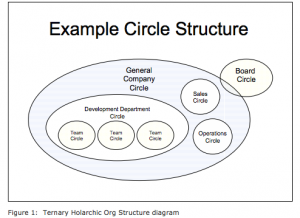Barely Managing to Lead: The Evolution of the Corporate Structure for Projects and Agencies

By Geoff Wilson, 352 Inc.,
The dawn of 2015 marked the beginning of an era for Zappos, the billion dollar online retailer. Company job titles no longer existed - and instead employees became part of a self-governing corporate structure where there are no managers.
Instead of a corporate hierarchy, Zappos is embracing a flatter "holacracy" structure that aims to distribute power more evenly. The new structure is made up of about 400 circles, or teams, of employees where the goal is to infuse leadership into each role.

Zappos may be the biggest corporate name in America to adopt a "holacracy" structure, but it is estimated that as many as 300 U.S. businesses are embracing this concept in order to become more resilient, innovative and responsive to customers.
Zappos' big experiment may be a bit extreme for most businesses, but there are some key elements of this way of thinking that can help any business or organization run better. They can be applied to entire corporate structures, as well as at the level of project management, where the goal is to fully satisfy the needs of the customer or stakeholder while meeting deadlines. (See image - source.)
 Creating a more efficient structure starts with changing how people are tasked to complete projects. The conventional way of tasking a project usually involves starting with a blueprint or scope of work, with various employees and specialists jumping in and out of the project at various points. One employee is typically working on multiple projects at once. This old way of working hamstrings creativity and kills efficiency because the process often gets stuck in hierarchical bottlenecks.
Creating a more efficient structure starts with changing how people are tasked to complete projects. The conventional way of tasking a project usually involves starting with a blueprint or scope of work, with various employees and specialists jumping in and out of the project at various points. One employee is typically working on multiple projects at once. This old way of working hamstrings creativity and kills efficiency because the process often gets stuck in hierarchical bottlenecks.
Alternatively, a more efficient, self-governed philosophy is grounded in the belief that people work best when in small, cohesive teams, dedicated to only one project at a time. This approach can be particularly effective for Web design and development agencies. This proved to be true at our firm, where prior to 2012, our way of organizing included a complex scheduling matrix, with everyone juggling several projects at a time, and a very stressed out traffic manager trying to keep everything straight. This old system, which many agencies still currently employ, made employees feel siled and like they were just a cog in an assembly line, with limited influence over the end product. Job quality and morale both suffered, especially as our agency grew and added more and more people.
When teams are organized into cross-functional teams, the goal then becomes creating the highest level of outcome for clients. Without project managers, every member of the team is responsible for the success of their project and client relationship and communicating with their client daily. Consider the following examples from our own agency, where each team shares the same characteristics and operating governances:
1) Singular Focus: Teams stay together from project to project, only working on one project at a time. These teams are singularly focused on a project from beginning to end. Instead of being given a project management template or being led by project managers, the teams manage themselves - prioritizing their work and making all of the decisions on what needs to happen to bring a project to completion.
2) Work in Sprints: Instead of long, drawn-out timelines, teams organize their projects in short segments of time, usually two-week increments, called sprints. It's up to the team to determine and commit to their client what tasks can be completed in each sprint period. This empowers the team to manage their own deadlines and encourages rapid progress and accountability with the client.
3) Freedom to Innovate: At the end of each sprint, the teams are free to re-prioritize their backlog of future tasks based on client feedback, user feedback or analytics analysis.. This freedom encourages disruptive, innovative ideas that improve the project to arise during development. Innovation is encouraged instead of being hampered by change orders.
4) Clients are a Core Team Member: Teams put their clients at the center of the project by hyper-communicating with them. Every day, there is a 15-minute meeting with the client and the team during which each team member tells the client what he or she did in the past 24 hours, what he or she will do in the following 24 hours and any roadblocks he or she is encountering. Teams also invite clients into their Slack channel and chat as needed throughout the day. The result of this level of communication is collaboration, deeper relationships with the client, demonstrable progress and positive outcomes.
5) Teams First: Teams are encouraged to create their own team values and name their team. Teams manage their own team budgets and are responsible for the health of all of their client relationships. Teams are also responsible for hiring new members onto their team. In many ways, each team becomes their own small agency within our agency.
This elimination of a hierarchical system fosters motivation among team members, and intrinsically compels employees to find ways to add value to the project at every stage. The result is an increase in client satisfaction and the speed in which projects are completed. Managers in the agency become servant leaders, where their first responsibility is to empower the team members in the execution of each project.
The beauty of this approach is that it can be applied at just about every business or organization for positive results. And as companies continue to evolve in order to limit unproductive hierarchies, achieve maximum transparency and to leverage technology to accomplish more with less people, more and more businesses will be looking for a way to barely manage to lead.
Geoff Wilson is the President and Founder of 352 Inc., a digital product development agency specializing in product strategy, user experience design, custom Web development and digital marketing. 352 turns ideas into successful digital products for companies like AutoTrader, Microsoft and YouCaring.









